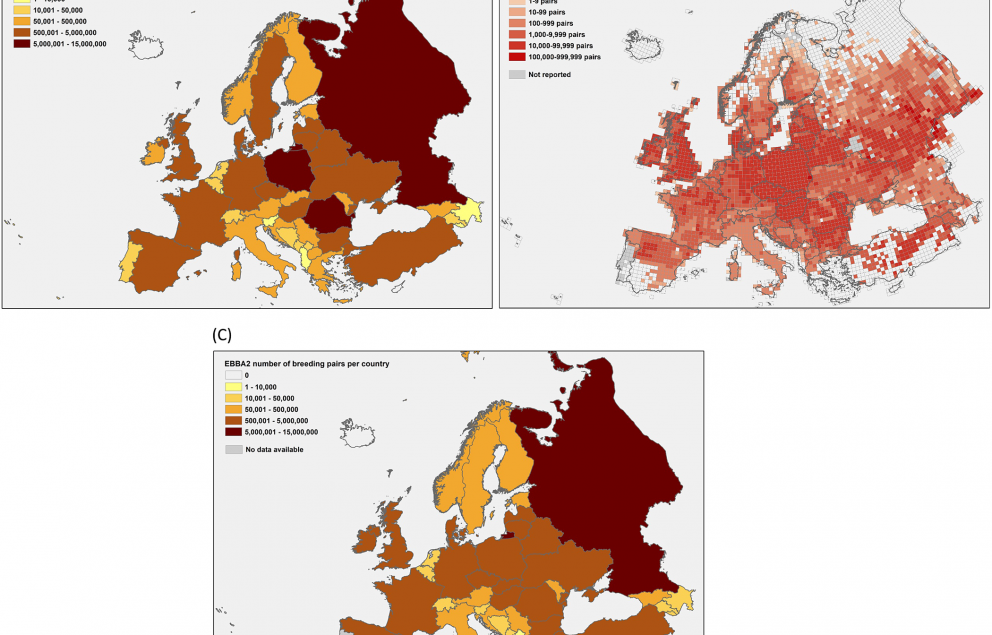
New publication on population estimates! Improving national bird population estimates in Europe: insights from comparisons with atlas abundance data.
June 14, 2024 | alena.klvanova
On 13 May 2024, researchers from the EBCC and BirdLife International published a new paper about European bird population estimates. The article can be openly accessed in the journal Bird Conservation International. Population sizes collated in the European Red List of Birds (ERLoB), and the abundances compiled in the European Breeding Bird Atlas 2 are compared at country and continental levels to find ways to improve the process of estimating bird populations in Europe.
In Europe, population estimates of breeding birds are produced nationally and are periodically compiled at EU or pan-European scales. Until now, no other source was available to explore the robustness of these estimates. In this study, the authors compared population sizes reported in the latest edition of the European Red List of Birds (ERLoB) with those produced using data from the second European Breeding Bird Atlas (EBBA2) to assess their consistency and determine parameters behind variability in population estimates that deserve further attention in the future.
European population estimates derived from summing local abundance data from EBBA2 were generally similar to those obtained from ERLoB. However, some species differed considerably, particularly in those distributed mainly in southern Europe. National population estimates from EBBA2 also did not differ markedly from those in ERLoB. However, we found that EBBA2 provided larger national population sizes than ERLoB for widespread species, suggesting that spatial information is more relevant for adequately assessing their population size than for localised species. The analysis also showed that, in general, population estimates based on robust methodological protocols (e.g. complete counts, statistical inference) contributed to reducing differences between ERLoB and EBBA2 values. Interestingly, EBBA2 and ERLoB estimates were quite similar for species classified in Europe as “Threatened” or “Near Threatened”. In contrast, the values for “Least Concern” species consistently differed between these two sources. Our results indicate which type of species would benefit from additional efforts to improve national population estimates and their consistency across countries, issues that are of paramount importance for guiding conservation strategies in Europe.
The authors greatly thank the broad community of European ornithologists and birdwatchers that made EBBA2 and ERLoB possible. A special acknowledgement goes out to all coordinators and data providers who work on behalf of national ornithological organisations in close cooperation with EBCC and BirdLife International.
Sergi Herrando, Sara Fraixedas, Lluís Brotons, David Martí, Anna Staneva, Verena Keller, Petr Voříšek & Ian J. Burfield
How to cite the data paper:
Herrando S, et al. Improving national bird population estimates in Europe: insights from comparisons with atlas abundance data. Bird Conservation International. 2024; 34: e16. https://doi.org/10.1017/S0959270924000054

Figure 1. Population estimates (number of breeding pairs) for the Eurasian Skylark Alauda arvensis for European countries: (A) ERLoB; (B) EBBA2 abundance estimates per 50-km square; (C) sum of EBBA2 abundances for all 50-km squares per country. Note that (B) is an intermediate product used to generate (C), i.e. EBBA2 population estimates, which are used for the comparison with (A), i.e. ERLoB population estimates. Regarding EBBA2, note that when more than 50% of the squares occupied by the species in a country had no 50-km data on abundance (not reported), the overall population estimate was not assessed (see grey squares across Portugal in map B and the resulting missing population estimate for that country in map C). When this percentage was lower than 50%, the average number of breeding pairs per 50 km square in the country was used as an estimation for the squares missing an abundance value, and thus, a total population for the country could be estimated (see few grey squares in Finland or European Russia in maps B and the resulting estimation of the population for these countries in map C).